If you are a cook and not interested in ready-made and fast food, you will need spices for cooking dishes and desserts, especially if you are a fan of variety in cooking and trying new foods. In the following, we have presented a list of 20 essential spices in every kitchen: dried seeds, tree bark, dried aromatic fruits, and vegetables.
1. CARDAMOM
We are all familiar with these fragrant seeds hidden inside bright green pods. Cardamom is used in Indian, Middle Eastern, and Scandinavian cuisines, from meat dishes to tasty, aromatic cookies. Cardamom has a sweet, piney, almost menthol aroma and taste that can overpower the flavor of food, but when used in moderation, it blends well with other spices and creates a mild and lovely scent. You can add cardamom pods directly to food, grind them into powder, open them, scoop out the cardamom seeds, and then powder them. About one teaspoon of ground cardamom is obtained from 10 whole cardamom pods or 100 grains.
If the recipe says to use black cardamom, do not substitute it with green cardamom. Larger black cardamom pods have a more robust, smoky flavor and are more suitable for non-sweet dishes.
2. chili pepper
There are many types of chili peppers in the world. You need at least one kind of pepper in your kitchen, but if your budget allows, it is better to buy several types. Chili pepper flakes available in the market are dried and then crushed peppers. Sometimes they contain a combination of several types of pepper and, occasionally, only one variety.
One of the types of chili peppers in the market is made from cayenne peppers. This red pepper only adds spiciness to the food and does not create a unique taste. It means that you can easily use it in different cooking recipes, but you cannot use chili peppers with more flavor in every food. For example, reddish-brown ancho chile powder’s earthy, sweet taste is more suited to Mexican cuisine. In contrast, the citrusy heat of fiery red Kashmiri chili powder shines in South Asian cuisine. Tin pepper has an earthy flavor and is suitable for Middle Eastern recipes such as muhammara.
3. Allspice or Allspice
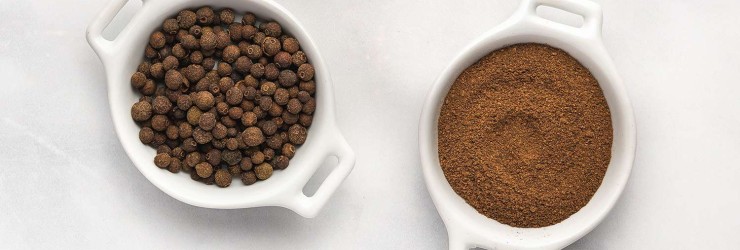
Chilies add aromatic heat to sweet and non-sweet foods. Allspice has a complex taste and aroma and is obtained from a unique dried fruit and sometimes ground. Allspice has a smoky, nutty flavor with notes of cloves, cinnamon, and black pepper and is often used in Caribbean and Mexican cuisine.
4. Cinnamon
Cinnamon is one of the most popular hot spices but is not a simple and essential spice. This spice may be very aromatic and strong enough to change the taste of the food completely. There are four commercial types of cinnamon from the genus Cinnamomum. The cinnamon we usually use in cooking is cassia or Ceylon cinnamon. Dark and sweet cassia cinnamon is generally produced in Vietnam, Indonesia, and China and is sold as a powder or cinnamon sticks. Ceylon cinnamon, also called “true cinnamon,” is primarily grown in Sri Lanka and has a milder aroma and a less sweet, citrusy flavor.
Different types of cinnamon can be used interchangeably, but they have differences in taste. It is better to prepare different kinds of cinnamon and taste them to find out which one you like best. Maybe you can use one to prepare sweets and cookies and the other for food.
5. cloves
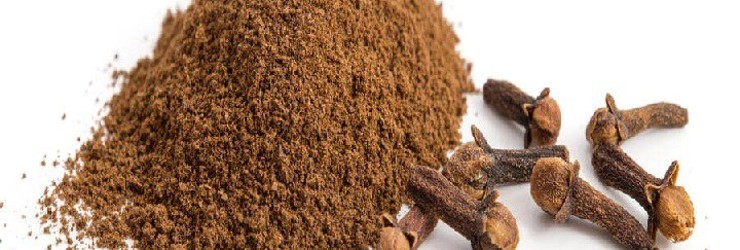
Sweet and aromatic cloves are bright pink when fresh, turn reddish brown when dried, and taste like molasses. Cloves can be used in various foods, such as chicken and meat broth or pumpkin cake. Cloves are native to Indonesia, but today they are also produced in Sri Lanka, Zanzibar, and India. Although other cloves have the same base notes, varieties grown in other regions may have various forms and be smoky or sweet.
6. coriander seeds
These yellowish-brown seeds are the fruit of a plant called coriander. These seeds have a unique and different taste with fresh and delicate coriander leaves. Fragrant and crunchy coriander seeds give your food a citrus taste. You can use them straight or ground in various foods, pickles, drinks, and sauces.
7. Cumin
Cumin, used for thousands of years in Central and Western Asia, was brought to North and South America by the Spanish and Portuguese colonists. This smoky, citrusy, and aromatic spice is used in many Indian, Moroccan, Chinese, and Mexican dishes. Cumin seeds are fine enough to add directly to food, but using ground cumin to mix them evenly with foods like bean paste is better.
8. fennel seed
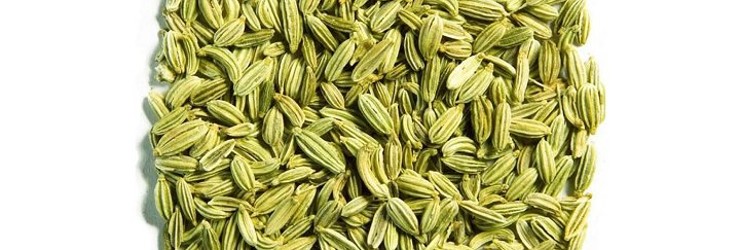
Today, fennel seeds are usually produced in India, Egypt, and Turkey. Fennel seeds are about the size of the green fennel plant and have an earthy, licorice-like flavor. Fennel seeds can be used in everything from muffin toppings to panna cotta, fried chicken, and spiced oil drizzled over fresh tomatoes.
9. Garlic powder
Although garlic powder is obtained by drying and pulverizing fresh garlic, it has a different taste from garlic itself. Garlic powder has the same non-sweet and smelly flavor notes as fresh garlic minus its moisture and spiciness. Therefore, garlic powder is ideal for mixed spices, snacks, and roasted corn. Although fresh garlic develops a more robust flavor when grated, garlic powder retains its mild flavor. You can use garlic powder in seasonings and sauces that must be stored for a few days and not consumed immediately.
10. ginger
Dried and ground ginger is much more potent than fresh ginger roots because the number of ginger’s pungent shogaol compounds increases during drying. (Shogaol compounds are aromatic biochemicals found in the plant.) About a quarter of a teaspoon of ground ginger is equivalent to 1 tablespoon of freshly grated ginger. Ginger is usually produced in India and China. This aromatic spice gives sweet and spicy heat to various foods and sweets.
11. mustard
This spice is obtained from mustard seeds. When you heat mustard seeds in a dry pan or oil, they release a pungent, aromatic spiciness. This spice can be used in salty, pickled liquid, and oily sauces such as salad dressing and tadka. Yellow mustard seeds are milder than brown mustard. But if you see black mustard somewhere, you can try it too. Black mustard is even more pungent than brown mustard. All three types of mustard can be used interchangeably, but if you use a more robust variety, start with a small amount and gradually increase the amount.
12. Nutmeg Hindi
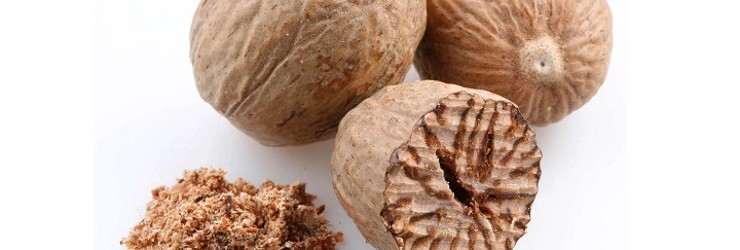
According to historical accounts, nutmeg was so valuable to the Dutch colonists that they traded Manhattan for the Banda Islands in Indonesia with the British. (At the time, the Banda Islands were the only source of this spice worldwide.) Nutmeg is grown throughout the Caribbean, India, Sri Lanka, Indonesia, and the Philippines today. Nutmeg is very aromatic and has a nutty sweetness. It is better to buy it whole and not ground because, usually, the powder has lost its aroma and freshness. Nutmeg has become a staple in many recipes, from béchamel sauce to spiced cookies.
13. Oregano
Cultivated throughout the Mediterranean and often in Greece, Turkey, and Italy, Greek oregano is a member of the mint family and can be found in many grocery stores. You may know that dried oregano isn’t just great for pizza. In addition, dried oregano can be replaced with fresh in most recipes. Just substitute one teaspoon of dried oregano with one tablespoon of fresh oregano. The Mexican oregano species, cultivated in Mexico and other regions of Latin America, has a more earthy taste and is a type of flower. You can use this aromatic herb in Mexican recipes.
14. paprika
Paprika powder is prepared from one of the varieties of chili pepper called ornamental pepper (Capsicum annuum). Of course, because it has a distinctive taste and is very common in cooking recipes, it has its name. Paprika is available in sweet, smoky, and hot varieties and gives a fiery red color to your food. Smoked paprika is dried over a fire and not air-dried like other paprika types.
15. pepper
Pepper, especially black pepper, is among the most common household spices. Unground black peppercorns are used in many dishes. These seeds give mild heat to the food. The black pepper plant (Piper nigrum) is also the source of 2 other pepper seeds, which are all the same fruit and differ only in terms of the stage of ripening or processing. One is green peppercorns, which are picked before the fruit is fully ripe, and have a fresher taste than black peppercorns. Another is white pepper, obtained by soaking pepper seeds in water and fermenting them. White pepper is mainly used in European and Southeast Asian cuisines.
16. Saffron
Saffron is expensive, but given that you only need a small number of its red strands to add a uniquely aromatic, herbaceous, honey flavor and a beautiful golden hue to foods and desserts, it is well worth the money you pay. One of the essential spices in many Iranian, Indian, Spanish, and Italian rice dishes is saffron, Dishes like Sachin, biryani, paella, and risotto, and desserts like creamy shrikhand and sponge milk cake.
17. Star Anise
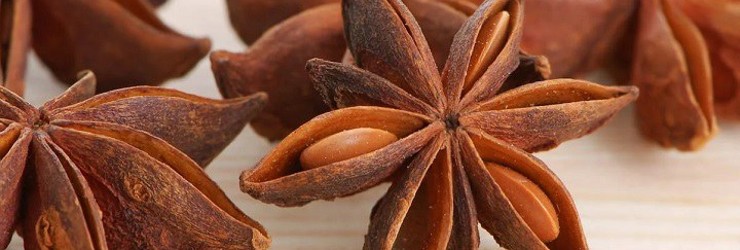
Anise is very aromatic, has licorice notes, and is used in many Chinese and Vietnamese recipes. Using its whole pods gives a solid aroma to any broth or stock. Like many warm smoky spices, star anise powder adds a pleasant scent to desserts.
18. sumac
Sumac has been used in cooking for centuries in the Middle East. The red fruits of sumac are from the cashew family, which means they are flowering and fruiting shrubs like pink peppercorns. One of the traditional methods of producing sumac is processing and growing it with salt. In this method, sumac’s unique color and taste (compared to drying it in the sun) is better preserved. This spice goes well with anything and can be used in many foods, drinks, and desserts.
19. Thyme
Greek, Turkish, and French thyme are all from the mint and oregano family. Therefore, thyme is also one of the aromatic plants with a pine aroma, considered an essential ingredient in Mediterranean and Southern European recipes. If you want fresh herbs, use one tablespoon of fresh thyme instead of every teaspoon of dry thyme. Lemon thyme is also a popular sub-branch of thyme that should only be used when we need citrus flavor and aromatic herbal aroma in our food at the same time.
20. Turmeric
Nowadays, turmeric is trendy due to its anti-inflammatory properties. This spice has been one of the main cooking ingredients in India and Southeast Asia for centuries. The root of the turmeric plant, which belongs to the ginger family, is bright orange and gives food a yellow color. Turmeric is used in recipes such as chicken and cashew food, spicy rice noodles, and coconut pie.
final word
The spices you buy and use depend on your favorite foods and personal taste, and you don’t have to buy the 20 spices introduced in this article! In addition to this, there are other valuable spices, such as fenugreek seeds, bay leaves, black cumin, celery seeds, curry leaves, dried dill, fenugreek, marjoram, black seeds, onion powder, and dried rosemary.
you say
Undoubtedly, you are familiar with some of the spices in this list, but some of them, like star anise, are probably not familiar names. Are you okay with trying new herbs or prefer sticking to tried-and-true herbs?



